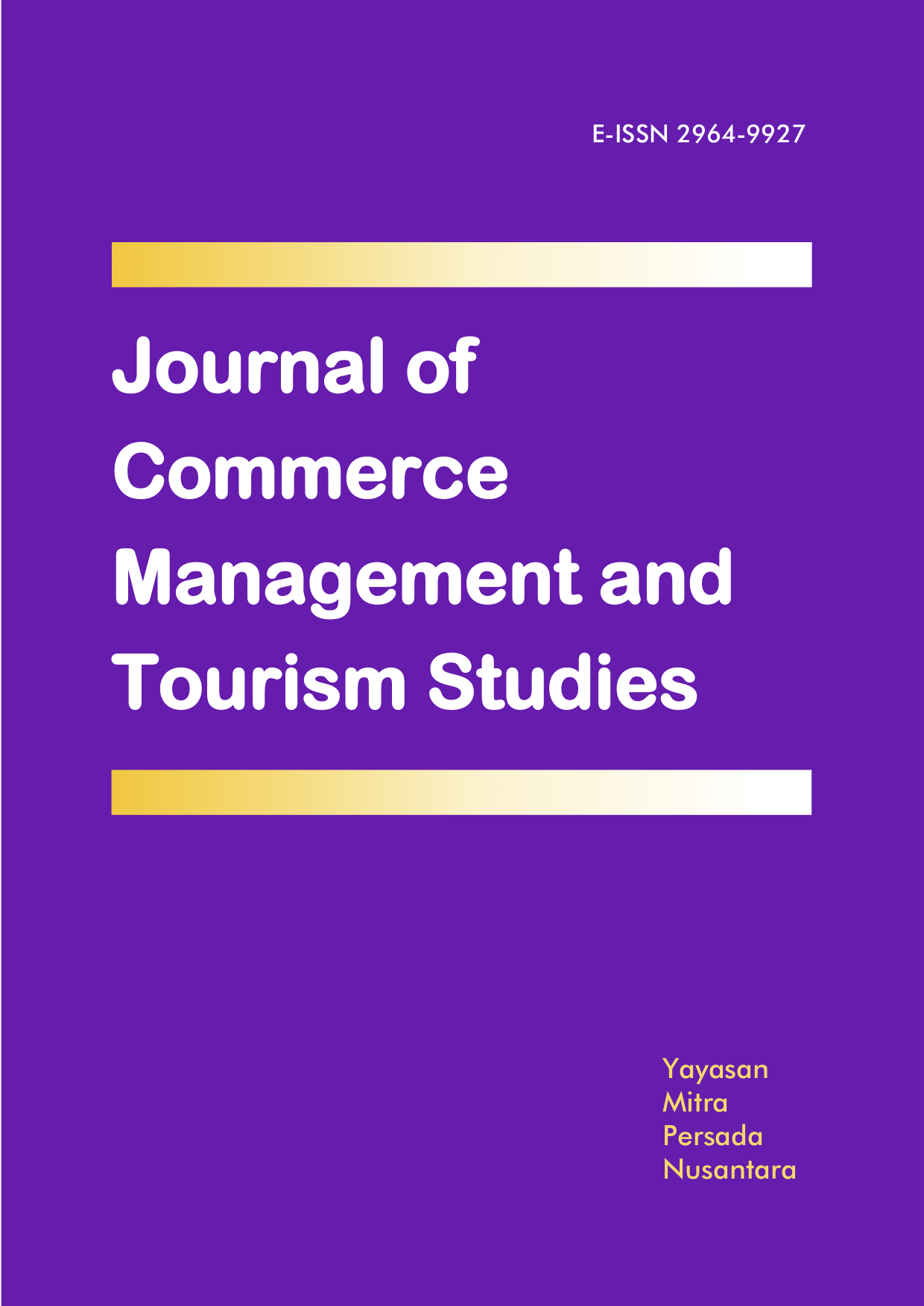Workplace technology adoption and organizational change in Nigerian customs service
DOI:
https://doi.org/10.58881/jcmts.v4i2.368Keywords:
orkplace Technology Adoption, Organizational Change, Digital Literacy Level, Employee Engagement, High-Speed Internet, Organizational NetworkingAbstract
The general objective of this research delves into workplace technology adoption and organizational change in the selected Nigerian Customs Service, South-South Zone. The specific objective is to assess the level of the relationship between digital literacy and employee engagement. The study used a correlational survey design and questionnaire to collect data. The total population of the study comprised 565 employees. The sample size was determined statistically using the Taro Yamane formula and calculated as 234. A proportional allocation formula determines the number of surveys for each stratum- River, Bayelsa, Edo, Akwa Ibom, and Delta State, Nigeria. Out of 234 copies of a questionnaire sent to the participants, only 205 were returned and utilized for the study while the remaining 29 copies were not used. The hypotheses were statistically tested and analyzed using Pearson correlation methods at a 5% significance level. The findings of the research hypothesis revealed that digital literacy level (skills) positively correlates with employee engagement. This result confirms a positive result with the value of (p= .000, r = .991, N = 205). The researcher recommends that organizations should increase investment in continuous technological upgrades. The Nigerian Customs Services should prioritize continuous investment in modern technologies that align with global best practices. These include blockchain for trade transparency, AI-powered analytics, and IoT for real-time tracking of goods. Regular training programs should be implemented to enhance staff digital literacy and ensure the smooth adoption of new technologies. Training should focus not only on technical skills but also on change management to overcome resistance.
Downloads
References
Advanced Commercial Interiors (2024). Everything you need to know about the digital workplace. Retrieved from https://www.aci.uk.net/workplace-technology-guide/
Ahmady, G. A., Mehrpour,M., & Nikooravesh, A. (2016). Organizational structure. 3rd International conference on new challenges in management and organization: organization and leadership, 2nd May 2016, Dubai, UAE. Procedia-social and behavioral science, 230, 455-462.
Aizenman, J., Lee, M., & Park, D. (2012). The relationship between structural change and inequality: A conceptual overview with special reference to developing Asia. ADBT working paper 396. Tokyo: Asian Development Bank Institute:
Almeida, F., Santos, J. D., & Monteiro, J. A. (2020). The challenges and opportunities in the digitalization of companies in a Post-COVID-19 World. IEEE Engineering Management Review, 48 (3), 97-103.
Al-Nashmi, M. M., & Ali-Ame, R. (2024). Examined the impact of information technology adoption on employee productivity in non-governmental organizations in Yemen. International Journal of Social Science and Humanities Research, 3 (2), 32-50.
Bajwa, B. (2023). Trends: automation to transform the modern workplace. Retrieved from https://research.g2.com/insights/workplace-automation-trends-2024.
Bejaković, P., & Mrnjavac, Ž. (2020). The importance of digital literacy on the labor market. Employee Relations, 42 (4), 921-932. Retrieved Online from https://doi.org/10.1108/ER-07-2019-0274
Bikse, V., Lusena-Ezera, I., Rivza, P., & Rivza, B. (2021). The development of digital transformation and relevant competencies for employees in the context of the impact of the COVID-19 pandemic in Latvia. Sustainability, 13 (16), 9233. Retrieved Online from https://doi.org/10.3390/su13169233
Blackburn, S., Harrington, T., Vidler, A., & Weddle, B. (2021). Government transformations in times of extraordinary change: Key considerations for public-sector leaders. Retrieved Online from https://www.mckinsey.com/industries/public-sector/our-insights/government-transformations-in-times-of-extraordinary-change-key-considerations-for-public-sector-leaders
Bozkus, K. (2023). Organizational culture change and technology: Navigating digital transformation. Retrieved Online from https: www. www.intechopen.com/chapters/88132
Buchanan, T. (2024). The importance and benefits of technology in the workplace. Retrieved Online from https:// www.buchanan.com/benefits-technology-workplace/
Chan, A.J., Hooi, L.W., & Ngui, K.S. (2021). Do digital literacies matter in employee engagement in a digitalized workplace? Journal of Asia Business Studies, 15(3), 523-540. https://doi.org/10.1108/JABS-08-2020-0318.
Chepkurgat, R.A., Kipkebut, D.J., and Auka D. (2019). The effects of organizational change on performance in Kenyan chartered Universities. A sector comparisons’ European Journal of Business and Management (EJBM).
Chukwurah, D.J., Uzor, O. A., Iwuno, J.O. & Chukwueloka, C.S. (2020). capacity building and employee productivity in the Nigerian public sector. A study of Anambra State Civil Service Commission, Awka. Global Journal of Political Science and Administration, 8 (5), 52-64.
D’Alessandro, R. (2024). Employee engagement at work: definition and guide. Retrieved Online from https://www.qualtrics.com/experience-management/employee/employeeengagement
Dastane, O. (2020). The impact of technology adoption on organizational productivity. Journal of Industrial Distribution and Business, 11(4), 7-18.
DataReporter (2024). Internet adoption in Nigeria. Retrieved from https://datareportal.com/digital-in-nigeria
Del Aguila‐Obra, A.R. and Padilla‐Meléndez, A. (2006). Organizational factors affecting internet technology adoption. Internet Research, 16 (1), 94-110. Retrieved Online from https://doi.org/10.1108/10662240610642569
Future Learn (N.D). What is digital literacy? Retrieved Online from https://www.futurelearn.com/info/courses/digital-skills-awareness-for-starting-higher-education/0/steps/228444
Gartner, I. (2023). Digital transformation. Retrieved from https://www.gartner.com/en/newsroom/press-releases/2023-04-17-gartner-announces-the-top-10-government-technology-trends-for-2023.
Ghasemy, M., & Hussin, S. (2014). Change leadership and change. Oriented leadership theories in higher education: A review. Conference: Seminar Kebangsaran Majilis Dekan-Dekan Pendidikan / PTA 2014. University of Malaya Malaysia.
Gupta, R., & Sharma, V. (2022). Digital literacy and employee engagement in the Government Sector. Journal of Public Administration Research and Theory, 32 (1), 45-67.
Henriksen, D., Mishra, P., & Mehta, R. (2016). The role of creative technologies in promoting collaborative creativity. Frontiers in Psychology, 7, 1765. DOI: 10.3389/fpsyg.2016.01765.
Huu, P.T. (2023). Impact of employee digital competence on the relationship between digital autonomy and innovative work behavior: a systematic review. Artificial Intelligence Review, 56, 14193–14222. https://doi.org/10.1007/s10462-023-10492-6
Huy, Q. N. (1999). Emotional capability, emotional intelligence, and radical change. Academy of Management Review, 24, 325–345.
Jamali, H., Dascalu, S. M., & Harris Jr, F. C. (2024). Fostering Joint Innovation: A Global Online Platform for Ideas Sharing and Collaboration. Retrieved Online from https://www.arXiv.org
Lakhwani, M., Dastane, O., Satar, N. S. M. (Johari, Z (2020). The impact of technology adoption on organizational productivity in Malaysia. Journal of industrial distribution and business. 11 (4), 7-18.
Lei, H., Tang, S., Zhao, Y., & Chen, S. (2024). Enterprise digitalization, employee digital literacy, and research and development cooperation: the moderating role of organizational inertia. Chinese Management Studies, 18 (2), 479-505. https://doi.org/10.1108/CMS-10-2021-0456.
Linley, P. A., Harrington, S., & Garcea, N. (2010). Oxford handbook of positive psychology. Oxford University Press: New York.
Medlin, B. D. (2001). The factor that may influence a faculty member’s decision to adopt electronic technologies in instruction. Doctoral Dissertation, Virginia Polytechnic Institute, and State University, 2001) ProQuest Digital Dissertations. UMI NO. 3095210
Ogundare, J.T., Iyamabhor, M. and Ojieh, M. (2023). Technology adoption management strategies and organization performance, evidence from telecommunication industry in Nigeria. International Journal of Academic Accounting Finance and Management research (4): 28-36.
Olarenwaju, B.E (2026). Effects of information technology on organization performance in Nigerian Banking Industries Accounting Department, Federal Polytechnic Ado-Ekiti. Research Journal of Finance and Accounting, 7 (3). 2222 – 2847.
Ongell V., Yavuz, M.S., TatL. H.S. (2022). Factors affecting digital literacy of human resources, upravelenced the manager, Beykent University. Istanbul, Turkey. Journal of Economic Literature, 13 (1), 68-83, 2022.
Parisot, A. H. (1995). Technology and teaching: the adoption and diffusion of technological innovation by a community college faculty (Doctoral dissertation, Montana State University 1995) ProQuest Digital Dissertations UMI No. AAT9542260
Rogers, E. M. (2003). Diffusion of innovation (5th ed). New York: Free Press.
Sahin, I. (2006). Detailed review of rogers diffusion of innovation theory and educational technology-related studies based on Roger’s theory. Journal of Education Technology, 5(2), 1303-6521.
Salim and Kawanto (2024). The influence of green human resource management on service innovation performance: The role of change-oriented organizational citizenship behavior Brawijaya University, Malang, Indonesia.
Sarachuk, K., Missler-Behr, M., Hellebrand, A. (2021). Ultra high-speed broadband internet and firm creation in Germany. In: Rodionov, D., Kudryavtseva, T., Skhvediani, A., Berawi, M.A. (eds) Innovations in Digital Economy. SPBPU IDE 2020. Communications in Computer and Information Science, 1445. Springer, Cham. https://doi.org/10.1007/978-3-030-84845-3_3.
Shalion (2024). Digital evolution: understanding internet adoption, time spent and usage. Retrieved Online from https://www.shalion.com/blog-posts/digital-evolution-2024-understanding-internet-adoption-time-spent-usage
Smith, T., Kindness, D., & Kvilhaug, S. (2024). What is employee engagement? Definition, strategies, and examples. Retrieved Online from https://www.investopedia.com/terms/e/employee-engagement.asp
Smitham, M. (2022). Top three trends in public sector digital services. Retrieved Online from https://www.mendix.com/blog/public-sector-trends/
Society for Human Resource Management, (SHRM, 2024). Employee engagement and increased performance. Retrieved Online from https://www.shrm.org/hr-today/trends-and-forecasting/special-reports-and-expert-views/documents/employee-engagement-commitment.pdf
Stobierski, T. (2020). Organizational change management: what it is and why it is important. Retrieved Online from https://www.online.hbs.edu.
The Guardian (2024). More time, less tedium: how AI is helping SMEs to innovate and compete.
Twinkl (N.D). Digital literacy. Retrieved Online from https://www.twinkl.com.ng/teaching-wiki/digital-literacy
Ugwu, K. E. (2012). Mergers and acquisitions- research agenda of x-logistics firm. Lambert Academic Publishing, Germany.
Ugwu, K. E., Onwuka, E. M., Okwedy, U., Chris-Ejiogu, G., & Njoku, C. O. (2024). The Influence of Information Technology on Employee Responsiveness in the Telecommunications Sector, Nigeria. Innovations, 74 (6), 1795-1811.
Ugwu, K.E., Awah, S., Duru, E.E., & Onyeanwu, C. C. (2022). Digital transformation and operational performance of Nigerian financial sector. International Journal of Innovative Science, Engineering and Technology, 9 (11), 38-53.
University of Minnesota (2017). Organizational Change. Retrieved Online from https://open.lib.umn.edu/organizationalbehavior/chapter/14-3-organizational-change/#:~:text=Organizational%20change%20is%20the%20movement,procedures%2C%20technology%2C%20or%20culture
Wijaya, G. N. S., Yudiastra, P.P., Pratami, N. W. C. A., and Arista, M. Y. (2019). The impact between the uses of Information Technology, user ability onuer motivation and employee performance in Koperasi Kuta, Mimba, Idonesia INPL conference on cybernetics and intelligent systems (ICORIS) vol. 978(1): 7282 – 1474, 2019.
Yee, L., Chui, M., Roberts, R., & Issler, M. (2024). McKinsey technology trends outlook. Retrieved Online from https://www.mckinsey.com/capabilities/mckinsey-digital/our-insights/the-top-trends-in-tech
Zhao, L. He, Q, Guo, L., & Sarpon, D. (2023). Organizational digital literacy and enterprise digital transformation. Evidence from Chinese listed companies, IEEE Transactions on Engineering Mgt. in print. DDI: 10.1109/Tem. 2023. 3241411
Downloads
Published
How to Cite
Issue
Section
License
Copyright (c) 2025 Kurutst Rika Obadiah, Kelechi Enyinna Ugwu, Pauline Ihuoma Asiabaka, Odinakachi Charles Njoku , Patricia Onyinyechi Onyechere

This work is licensed under a Creative Commons Attribution-NonCommercial-NoDerivatives 4.0 International License.














